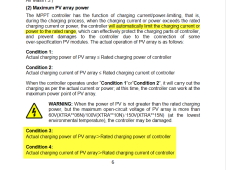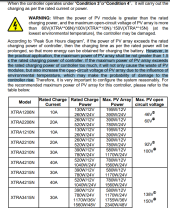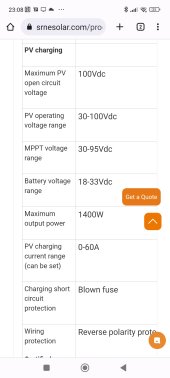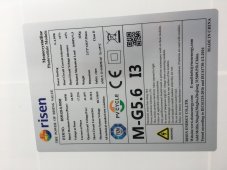12VoltInstalls
life passes by too quickly to not live in freedom
Setting the stage
I have intentionally bought too many watts of panels not because I need the watts- but rather because I wish to have enough voltage to create usable charging in poor sun /overcast conditions.
Overcast conditions are a consistent problem here in the Northeast Kingdom of Vermont Nov to January and Feb through March or later where we can go for weeks without any blue skies or seeing the sun - especially Nov and December.
Backdrop
I have read a number of threads and the opinions are all over the place in regards to how much one can over-panel an SCC- specifically the Epever units. If one divides the max panel figures from some of Epever’s literature by the max charge, one would surmise that one could roughly overpanel to 135% of charging max wattage.
The below quote is in regards to a 100VOC models (I have two new-in-box Triron 4215AN units) but the principal is the same:
Producing usable charging in suboptimal conditions is my goal.
While I’m aiming for a practical result with purpose, there is a secondary motivation of fun; an experimentation for entertainment value. However I am off-grid so things do have to work.
Specifications
I have six “NOS” new panels:
I have two 4215AN SCCs.
Some are going to ask about batteries and inverter. These are not relevant to the question because they will do what I need. But here it is:
I may add a third for capacity but I bought two cheapo/risky btrpower 140Ah LiFePo 12V ‘replacement batteries’ for this new system (because LiFePo doesn’t care if they are partly charged for a week or two, and they will basically take all of whatever 12.8VDC nominal I feed them) along with 125A Class T fuses for each battery.
The inverter I’m using is a QZRELB (aka Reliable) 2000W pure sine because it has quite low idle consumption; is well under my wiring ampacity; runs the coffeemaker, refrigerator and iron; and will start and run my smaller portable tablesaw.
So the above Epever published specs indicate a max watts of charge as 520W for a 12V system for the 4215AN. One 2S string exceeds that slightly and I’m sure that’s not an over-panel issue.
However, what about 2S2P? Or even 3S3P?!
If I use one controller at 2S: 630W and the other at 2S2P: 1260W; will that theoretical 1260W be “too much?” As best as I can tell it should be fine, and I do not care in the slightest about how many full-sun watts I “leave on the table.” This is about poor-weather charging not about maxing out my harvest. I already have plenty of power in the existing 800W FLA system during summer and sunny winter weather.
It seems it should work- it’s well under VOC and if it won’t pass >40A at nominal 12VDC the panels will not put out what they don’t see for a load, right? Or wrong?
But will a 4215AN just simply not pass the “extra” ~700W? Or fry?
There is a Part B but that isn’t relevant now as part A is not yet solved and I don’t want to add that separate independent discussion.
Thank you for your time. Hoping @chrisski and @Hedges and the other 4 or 5 usual enginerding suspects stop in.
I have intentionally bought too many watts of panels not because I need the watts- but rather because I wish to have enough voltage to create usable charging in poor sun /overcast conditions.
Overcast conditions are a consistent problem here in the Northeast Kingdom of Vermont Nov to January and Feb through March or later where we can go for weeks without any blue skies or seeing the sun - especially Nov and December.
Backdrop
I have read a number of threads and the opinions are all over the place in regards to how much one can over-panel an SCC- specifically the Epever units. If one divides the max panel figures from some of Epever’s literature by the max charge, one would surmise that one could roughly overpanel to 135% of charging max wattage.
The below quote is in regards to a 100VOC models (I have two new-in-box Triron 4215AN units) but the principal is the same:
So one could conclude that unlimited panel wattage is acceptable as long as one does not crowd the VOC max.Actually when you read the Epever Tracer AN manual very closely you will see that the figure "1.5x" the maximum charging power is given as a "suggestion" as they do not wish for you to waste money on excessive over-paneling. I interperate this paragraph as that there is NO specific maximum per se, as long as one stays under 100v.

Ultimate conversion efficiency is not my goal, here.The greater the voltage, the lower the efficiency. However, the reduced wiring losses often offset this.
Producing usable charging in suboptimal conditions is my goal.
While I’m aiming for a practical result with purpose, there is a secondary motivation of fun; an experimentation for entertainment value. However I am off-grid so things do have to work.
Specifications
I have six “NOS” new panels:
| REC Solar | 72 Series |
| Model Number | REC315PE72 |
| STC Rating | 315.0 |
| PTC Rating | 288.4 |
| Open Circuit Voltage (V) | 45.5 |
| Short Circuit Current (A) | 9.09 |
- Model: Triron4215N
- Rated charge current: 40 Amp
- Nominal system voltage:12V/24V DC
- Max. PV input power: 520W charge for 12V battery system / 1040W charge for 24V battery system
- Max. PV open circuit voltage:150V(at minimum operating environment temperature) ;138V(at 25℃ environment temperature)
- Grounding : Common negative
- Battery input voltage range : 8~32V
- MPP voltage range:V(BAT+2V)~72V
- Tracking efficiency : ≥99.5% , Max. conversion efficiency :98%
Some are going to ask about batteries and inverter. These are not relevant to the question because they will do what I need. But here it is:
I may add a third for capacity but I bought two cheapo/risky btrpower 140Ah LiFePo 12V ‘replacement batteries’ for this new system (because LiFePo doesn’t care if they are partly charged for a week or two, and they will basically take all of whatever 12.8VDC nominal I feed them) along with 125A Class T fuses for each battery.
The inverter I’m using is a QZRELB (aka Reliable) 2000W pure sine because it has quite low idle consumption; is well under my wiring ampacity; runs the coffeemaker, refrigerator and iron; and will start and run my smaller portable tablesaw.
So the above Epever published specs indicate a max watts of charge as 520W for a 12V system for the 4215AN. One 2S string exceeds that slightly and I’m sure that’s not an over-panel issue.
However, what about 2S2P? Or even 3S3P?!
If I use one controller at 2S: 630W and the other at 2S2P: 1260W; will that theoretical 1260W be “too much?” As best as I can tell it should be fine, and I do not care in the slightest about how many full-sun watts I “leave on the table.” This is about poor-weather charging not about maxing out my harvest. I already have plenty of power in the existing 800W FLA system during summer and sunny winter weather.
It seems it should work- it’s well under VOC and if it won’t pass >40A at nominal 12VDC the panels will not put out what they don’t see for a load, right? Or wrong?
But will a 4215AN just simply not pass the “extra” ~700W? Or fry?
How much is too much- and why?
There is a Part B but that isn’t relevant now as part A is not yet solved and I don’t want to add that separate independent discussion.
Thank you for your time. Hoping @chrisski and @Hedges and the other 4 or 5 usual enginerding suspects stop in.







